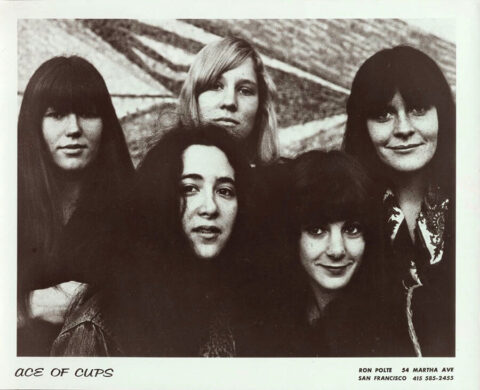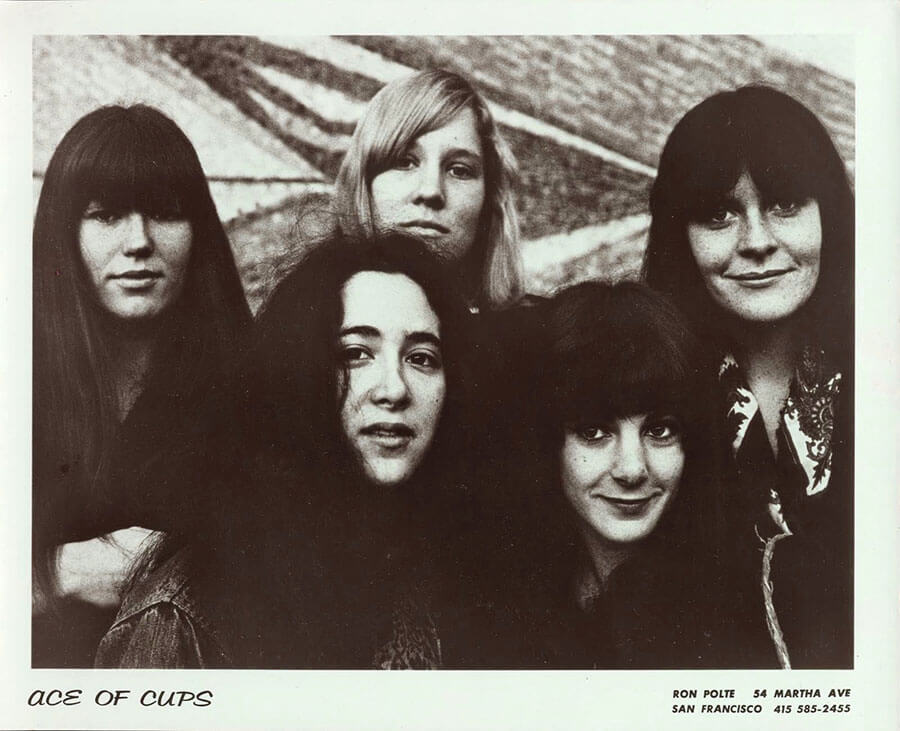(The Ace of Cups band members now, from left to right above: Mary Gannon, Diane Vitalich, Denise Kaufman, Mary Simpson.)
If we need any reminder that women don’t lose their musical mojo, enjoy the tale of what was likely the first all-girl rock band of note. That would be the Ace of Cups, which was based in San Francisco at the height of, well, the Haight. The band of five performed with headliners like Quicksilver Messenger Service, Country Joe and the Fish, and Jefferson Airplane. Bill Graham picked them to open for a (then) new group called The Band, and Jimi Hendrix, upon returning to England, said, “I heard some groovy sounds in America, like this girl group, Ace of Cups.”
Their music was original and feminist, but to the surprise and disappointment of many, the group never got a record deal. Sexism, anyone?
Until now.
Though each of the women is in her 70s, the Ace of Cups has been rediscovered, and their first album was just released. “This is a dream deferred,” says Denise Kaufman, who plays guitar, bass, and harmonica and has written much of the group’s material. “It’s magical,” adds guitarist Mary Ellen Simpson, who is simultaneously celebrating another grandchild. “I’ve been waiting 45 years for the debut album of Ace of Cups,” says longtime fan Jackson Browne.
The Meet Up
The five Cups—Kaufman, Simpson, Diane Vitalich, Mary Gannon, and Marla Hunt (Hunt is not involved, now)—met in 1966, when in their late teens an early 20s. Gannon, a former Miss Monterey, was working in an all-night donut shop, Simpson was studying art at a city college, and Kaufman was working at Fantasy Records. But their passion was music, and once they merged, they would often practice in record company’s studio upstairs. (Rotating with Kaufman’s co-worker, John Fogerty.) They started getting gigs in iconic venues like the Avalon and the Fillmore.
‘I’ve been waiting 45 years for the debut album of Ace of Cups,’ says longtime fan Jackson Browne.
Their songs upended the “It Must Be Him” sentiments of their youths—With their own lyrics like, “there are a whole lotta people tryin’ to mess with your mind.” They were soon part of the fabric of their place and time. None more so than Kaufman, who dropped out of Berkeley, where she was arrested in the free speech protests, at 18, and had temporarily hopped on Ken Kesey’s Merry Pranksters bus. At various points, she was apparently the focus of many a famous male’s life. (Hint: Check out the current biographies of Paul Simon and Jann Wenner.)
A Passing Moment

Back in the day: Marla Hunt, Denise Kaufman, Mary Ellen Simpsons, Diane Vitalich, and Mary Gannon.
But the summers of love eventually ended, and by 1972, the Ace of Cups’ moment passed. (“I like to say we faded away,” says drummer Vitalich.) What followed were their version of normal lives: relationships, (“A lot of hookups and wrong choices,” says Gannon); babies; and geographical changes. Simpson returned to school and eventually became a substance abuse and mental health specialist. Gannon also went back to college and got a degree in education; she has six children. Vitalich cleaned houses three days a week, and Kaufman, who was married briefly and gave birth to a daughter, moved part time to Kaua’i, where she started a still operating organic farm, and with six local women, opened a school, which has grown in size and stature.
There was some pain in watching decades go by, as other girl groups like the Bangles and Runaways emerged.
Regardless of what they were doing, the music continued. “I never put down the guitar,” says Simpson who, like Vitalich and Gannon, played locally with several bands over time. There was some pain in watching decades go by, as girl groups like the Bangles and Runaways emerged, who proved you could strum and scream and still sell records. “I felt glad for them, but I did feel sad that we had so much music out there, that so many people had never heard,” says Kaufman.
The Ace of Cups Band: A Dream Deferred
That may now change, thanks to High Noon Records in New York. Its founder, George Wallace, heard some of the Cups’ old tapes and fell hard. He brought in producer Dan Shea, who had worked successfully with female artists like Mariah Carey, Celine Dion, and Jennifer Lopez. He and Wallace knew instinctively that an album just for nostalgic purposes would not be enough: that the songs—most are the originals though a few are new—had to stand alone.
“Some of the songs are virtually unchanged from the way they played them in the late ‘60s,” says Shea, and others went through major rewrites. As for worrying about their, um, seniority, Shea says, “they had very little experience in the studio so the learning curve was quite steep. But I was really amazed at the way they embraced the process and their energy levels. I’d be ready to call it a day and they’d say, ‘Hey, we can go a couple more hours if you can.’”
Their next dream is to get nominated for a Grammy as ‘Best New Artists.’
Ace of Cups members always prided themselves on refusing to go softer or sexier, and the age thing is not a personal concern. All are proudly gray, and, as Vitalich says, “we are finding it empowering to not try to be what we used to be.” The good vibes are already starting. KQED, the public TV station in San Francisco, did an eight-minute documentary about the group, which received five million views. “I’m overwhelmed by the blessings that have come to us,” says Vitalich.
The goals now are to sell some records, perhaps have their music used in film and television, and even find new young listeners. People like Leah Tashman, 22, an intern at High Noon. She had no idea who this group of women was but says, “I was blown away. I’d hear the words and it would never dawn on me they are written by women, let alone older ones.”
Denise Kaufman, a proud 72, smiles at responses like that and confesses her next dream: “We’d love to get nominated for a Grammy for best new artists.”
***
Michele Willens is a journalist and published playwright, and is currently a theatre commentator for NPR-owned Robinhoodradio. She writes frequently about culture for Huffington Post, The Atlantic, The Daily Beast, The New York Times, and The Los Angeles Times. She is co-author of FACE T: What Women Really Feel As Their Looks Change. She lives in New York with her husband, NBC News VP David Corvo, and their two children.





















0 Comments